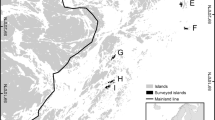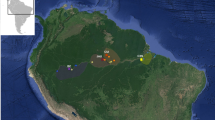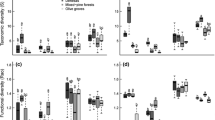Abstract
We examined the species richness patterns of five different species groups (mosses, reptiles and amphibians, grasshoppers and crickets, dragonflies, and hoverflies) in the Netherlands (41,500 km2) using sampling units of 5 × 5 km. We compared the spatial patterns of species richness of the five groups using Spearman’s rank correlation and used a stepwise multiple regression generalized linear modelling (GLM) approach to assess their relation with a set of 36 environmental variables, selected because they can be related to the several hypotheses on biodiversity patterns. Species richness patterns of the five groups were to a certain extent congruent. Our data suggest that environmental heterogeneity (in particular habitat heterogeneity) is one of the major determinants of variation in species richness within these five groups. We found that for taxonomic groups comprising a low number of species, our regression model explained more of the variability in species richness than for taxonomic groups with a large number of species.


Similar content being viewed by others
References
Alterra (2001) Het Landelijk grondgebruiksbestand Versie 4 (LGN4). Centrum voor Geo-informatie, Wageningen
Austin MP (1980) Searching for a model for use in vegetation analysis. Vegetatio 42:11–21
Bal D, Beije HM, Fellinger M et al (2001) Handboek Natuurdoeltypen. Report Expertisecentrum LNV, nr. 2001/020. EC-LNV, Wageningen
Bio AMF, Alkemade R, Barendregt A et al (1999) Geostatistical interpolation of abiotic site conditions in the Netherlands. A method for reference mapping. RIVM-report 408657003. RIVM, Bilthoven
Chapin SFIII, Zavaleta ES, Eviner VT et al (2000) Consequences of changing biodiversity. Nature 405:234–242. doi:10.1038/35012241
Colwell RK, Lees DC (2000) The mid-domain effect: geometric constraints on the geography of species richness. Trends Ecol Evol 15:70–76. doi:10.1016/S0169-5347(99)01767-X
Cormont A, Radix J, Segers M (2004) The spatial distribution of biodiversity over the Netherlands: the role of landscape age. MSc thesis natural resources management, Utrecht University
Crawley MJ (1993) GLIM for ecologists. Blackwell, London
Currie DJ (1991) Energy and large-scale patterns of animal- and plant-species richness. Am Nat 137:27–49. doi:10.1086/285144
Dennis RLH, Sparks TH, Harvey PB (1999) Bias in butterfly distribution maps: the effects of sampling effort. J Insect Conserv 3:33–42. doi:10.1023/A:1009678422145
Diniz-Filho JA, Bini LM, Hawkins BA (2003) Spatial autocorrelation and red herrings in geographical ecology. Glob Ecol Biogeogr 12:53–64. doi:10.1046/j.1466-822X.2003.00322.x
Dobson AJ (1999) An introduction to generalized linear models. Chapmann and Hall, Boca Raton
Dutilleul P (1993) Modifying the t test for assessing the correlation between two spatial processes. Biometrics 49:305–314. doi:10.2307/2532625
Gaston KJ (2000) Global patterns in biodiversity. Nature 405:220–227. doi:10.1038/35012228
Gaston KJ, Blackburn TM (1990) Effects of scale and habitat on the relationship between regional distribution and local abundance. Oikos 58:329–335. doi:10.2307/3545224
Godfray HCJ, Lawton JH (2001) Scale and species numbers. Trends Ecol Evol 16:400–404. doi:10.1016/S0169-5347(01)02150-4
Gongrijp GP (1989) Nederland in vorm. Aardkundige waarden van het Nederlandse landschap. Achtergrondreeks Natuurbeleidsplan nr. 5. Ministerie van Landbouw, Natuurbeheer en Visserij, ‘s-Gravenhage
Harcourt AH (2000) Coincidence and mismatch of biodiversity hotspots: a global survey for the order primates. Biol Conserv 93:163–175. doi:10.1016/S0006-3207(99)00145-7
Hawkins BA, Field R, Cornell HV et al (2003) Energy, water, and broad-scale geographic patterns of species richness. Ecology 84:1608–1623. doi:10.1890/0012-9658(2003)084[1608:PAHAPO]2.0.CO;2
Heikkinen RK, Neuvonen S (1997) Species richness of vascular plants in the subarctic landscape of northern Finland: modelling relationships to the environment. Biodivers Conserv 6:1181–1201. doi:10.1023/A:1018356823171
Hubbell SP (2001) The unified neutral theory of biodiversity and biogeography. Princeton University Press, Princeton
Huston MA (1994) Biological diversity: the coexistence of species in changing landscapes. Cambridge University Press, Cambridge
Kerr J (2001) Global biodiversity patterns: from description to understanding. Trends Ecol Evol 16:424–425. doi:10.1016/S0169-5347(01)02226-1
KNMI (2002) Klimaatatlas van Nederland. Elmar, B.V., Rijswijk
Legendre P (1993) Spatial autocorrelation: trouble or new paradigm? Ecology 74:1659–1673. doi:10.2307/1939924
Levin SA (1992) The problem of pattern and scale in ecology: the Robbert H. MacArthur award lecture. Ecology 73:1943–1967. doi:10.2307/1941447
Levin SA (2000) Multiple scales and the maintenance of biodiversity. Ecosystems (NY, Print) 3:498–506. doi:10.1007/s100210000044
Maes D, Bauwens D, de Bruyn L et al (2005) Species richness coincidence: conservation strategies based on predictive modelling. Biodivers Conserv 14:1345–1364. doi:10.1007/s10531-004-9662-x
MacArthur RH, MacArthur JW (1961) On bird species diversity. Ecology 42:594–598. doi:10.2307/1932254
Margules CR, Pressey RL, Williams PH (2002) Representing biodiversity: data and procedures for identifying priority areas for conservation. J Biosci 27:309–326. doi:10.1007/BF02704962
McCullagh P, Nelder JA (1989) Generalized linear models. Chapman and Hall, London
Millennium Ecosystem Assessment (2005) Ecosystems and human well-being: biodiversity synthesis. World Resources Institute, Washington
Myers N, Mittermeier RA, Mittermeier CG et al (2000) Biodiversity hotspots for conservation priorities. Nature 40:853–858. doi:10.1038/35002501
Nicholls AO (1989) How to make biological surveys go further with generalized linear models. Biol Conserv 50:51–75. doi:10.1016/0006-3207(89)90005-0
Olff H, Ritchie ME (2002) Fragmented nature: consequences for biodiversity. Landsc Urban Plan 58:83–92. doi:10.1016/S0169-2046(01)00211-0
Overbeek GJ, Beusen AHW, Boers PCM et al (2002) Plausibiliteitsdocument STONE 2.0 Globale verkenning van de plausibiliteit van the STONE versie 2.0 voor de modellering van uit- en afspoeling van N en P. RIVM rapport 718501001 RIVM, Bilthoven
Overmars KP, de Koning GHJ, Veldkamp A (2003) Spatial autocorrelation in multi-scale land use models. Ecol Modell 164:257–270. doi:10.1016/S0304-3800(03)00070-X
Pianka ER (1966) Latitudinal gradients in species diversity: a review of the concepts. Am Nat 100:33–46. doi:10.1086/282398
Prendergast JR, Quinn RM, Lawton JH et al (1993) Rare species, the coincidence of diversity hotspots and conservation strategies. Nature 365:335–337. doi:10.1038/365335a0
Rahbek C (1995) The elevation gradient of species richness: a uniform pattern? Ecography 18:200–205. doi:10.1111/j.1600-0587.1995.tb00341.x
Rahbek C, Graves GR (2000) Detection of macro-ecological patterns in South American hummingbirds is affected by spatial scale. Proc R Soc B Biol Sci 267:2259–2265
Rangel TFLVB, Diniz-Filho JAF, Bini LM (2006) Towards an integrated computational tool for spatial analysis in macroecology and biogeography. Glob Ecol Biogeogr 15:321–327. doi:10.1111/j.1466-822X.2006.00237.x
Rich TCG (1998) Squaring the circles—bias in distribution maps. Br Wildl 9:213–219
Rohde K (1992) Latitudinal gradients in species diversity: the search for the primary cause. Oikos 65:514–527. doi:10.2307/3545569
Segurado P, Araujo MB, Kunin WE (2006) Consequences of spatial autocorrelation for niche-based models. J Appl Ecol 43:433–444. doi:10.1111/j.1365-2664.2006.01162.x
Shmida A, Wilson MV (1985) Biological determinants of species diversity. J Biogeogr 12:1–20. doi:10.2307/2845026
SOVON vogelonderzoek Nederland (2002) Atlas van de Nederlandse broedvogels 1998–2000. Nederlandse Fauna 5. Nationaal Natuurhistorisch Museum Naturalis, KNNV Uitgeverij & European Invertebrate Survey-Nederland, Leiden, 584 pp (in Dutch)
Steur GGL, Heijink W (1992) Bodemkaart van Nederland, schaal 1:50.000. Stiboka, Wageningen
Tardif B, DesGranges JL (1998) Correspondance between bird and plant hotspots of the St. Lawrence river and influence of scale on their location. Biol Conserv 84:53–63
Tews J, Brose U, Tielbörger Grimm V et al (2004) Animal species diversity driven by habitat heterogeneity/diversity: the importance of keystone structures. J Biogeogr 31:79–92
van der Meijden R, Plate CL, Weeda EJ (1989) Atlas van de Nederlandse flora 3. Minder zeldzame en algemene soorten. Leiden: Onderzoekinstituut Rijksherbarium/Hortus Botanicus (in Dutch)
van Nieukerken EJ, van Loon AJ (1995) Biodiversiteit in Nederland. Nationaal Natuurhistorisch Museum, Leiden
Whittaker RJ, Nogués-Bravo D, Araújo MB (2007) Geographical gradients of species richness: a test of water-energy conjecture of Hawkins et al (2003) using European data for five taxa. Global Ecol Biogeogr 16:76–89
Williams PH, Margules CR, Hilbert DW (2002) Data requirements and data sources for biodiversity priority area selection. J Biosci 27:327–338
Wilson RJ, Thomas CD, Fox R et al (2004) Spatial patterns in species distribution reveal biodiversity change. Nature 432:393–396
Acknowledgements
Nienke van Geel is thanked for digitizing the climate maps. Jolijn Radix, Marja Seegers and Anouk Cormont are thanked for constructing the map of landscape age. Rogier Donders and Edzer Pebesma are greatly acknowledged for their helpful comments on the statistical analyses.
Author information
Authors and Affiliations
Corresponding author
Rights and permissions
About this article
Cite this article
Schouten, M.A., Verweij, P.A., Barendregt, A. et al. Determinants of species richness patterns in the Netherlands across multiple taxonomic groups. Biodivers Conserv 18, 203–217 (2009). https://doi.org/10.1007/s10531-008-9467-4
Received:
Accepted:
Published:
Issue Date:
DOI: https://doi.org/10.1007/s10531-008-9467-4




